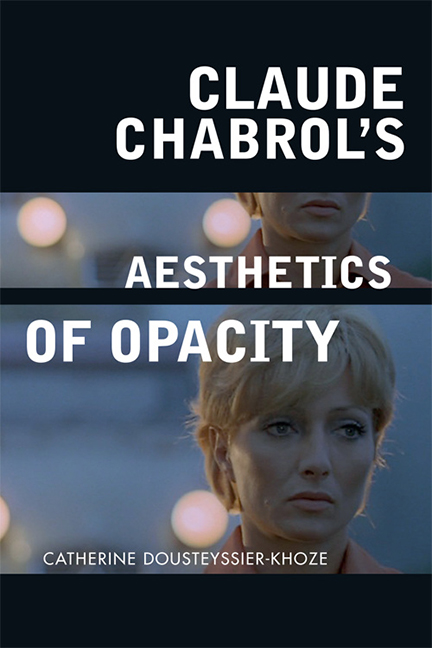Book contents
- Frontmatter
- Contents
- List of Figures
- Acknowledgements
- Dedication
- Introduction
- 1 Contexts and Influences
- 2 Chabrol and Genres
- 3 The Human Beast
- 4 Family Secrets
- 5 Chabrolean Spaces as Heterotopias of Crisis
- 6 Through the Looking Glass: Chabrol’s Mirrors and the ‘Crystal-image’
- Conclusion: Towards an Aesthetics of Visual Opacity
- Filmography
- Bibliography
- Index
Introduction
Published online by Cambridge University Press: 10 November 2020
- Frontmatter
- Contents
- List of Figures
- Acknowledgements
- Dedication
- Introduction
- 1 Contexts and Influences
- 2 Chabrol and Genres
- 3 The Human Beast
- 4 Family Secrets
- 5 Chabrolean Spaces as Heterotopias of Crisis
- 6 Through the Looking Glass: Chabrol’s Mirrors and the ‘Crystal-image’
- Conclusion: Towards an Aesthetics of Visual Opacity
- Filmography
- Bibliography
- Index
Summary
Claude Chabrol famously said that one of his key priorities was ‘ne pas emmerder le public’ (‘not to bore the audience stiff’). It is therefore slightly provocative to apply the label of ‘opacity’ to a director who always prided himself on the accessibility and entertainment value of his films. Yet, his overtly anti-elitist and popular approach to cinema was by no means achieved at the expense of creativity, artistic standards and depth of meaning, and one can get some precious insight into the ‘Chabrol paradox’ through another light-mooded yet revealing quotation of his: ‘Ce qui est drôle, c’est de faire des plans avec deux ou trois strates de lecture’ (‘Making shots with two or three reading grids, that's what's fun’). Much of what follows will be devoted to uncovering these intricate layers and threads that, film after film, however different or successful these are, contribute to the making of a shimmering, complex Chabrolean mosaic.
When Chabrol died in September 2010, he left behind him fifty-four full-length features, as well as a large number of TV films and three shorts. His next project was to be an adaptation of a Simenon novel, L’Escalier de fer, featuring Isabelle Huppert as a cold, sex-crazed homicidal maniac. This was Chabrol's second missed opportunity to adapt one of his favourite authors – indeed, he almost started his career by making Le Fils Cardinaud based on Georges Simenon's 1943 novel – and, no doubt, a great loss for cinema insofar as the combination of the thriller genre and the portrayal of a complex, enigmatic woman/murderess has always been a winning one for the director (Les Biches, Violette Nozière, La Cérémonie and Merci pour le chocolat).
The aim of Claude Chabrol's Aesthetics of Opacity is to explore the aesthetics of the French director, covering the full spectrum of his works from his first film (Le Beau Serge, 1958), which launched the Nouvelle Vague, to his last one (Bellamy, 2009), with Gérard Depardieu in the leading role. Chabrol's cinema is generally associated in the collective mind with a type of psychological thriller or melodrama set in the bourgeois confines of the French provinces.
- Type
- Chapter
- Information
- Claude Chabrol's Aesthetics of Opacity , pp. 1 - 5Publisher: Edinburgh University PressPrint publication year: 2017



